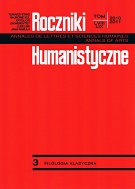Mosella Decimusa Magnusa Auzoniusza jako hodoeporikon
Mosella by Decimus Magnus Ausonius as a Hodoeporicon
Author(s): Anna KołtunowskaSubject(s): Language and Literature Studies
Published by: Towarzystwo Naukowe KUL & Katolicki Uniwersytet Lubelski Jana Pawła II
Keywords: Ausonius; Mosella; iter/hodoeporikon; genre; late ancient literature
Summary/Abstract: The presented article is a summary of the M.A. thesis entitled: Mosella by Decimus Magnus Ausonius as a hodoeporicon. The main assumption of the work is an attempt to establish the meaning of the term hodoeporicon/iter and to find its features in Ausonius’ Mosella. Difficulties in doing a research on this subject are caused by a scarce number of studies concerning this issue. In the article, the definition of hodoeporicon is based on three principal works written by J.C. Scaliger, J. Schnayder and R. Krzywy. A piece of literary work might be called hodoeporicon/ iter, if it is a sort of a report from a journey created in a form of a poem or a work of prose. It should give the names of the visited places, contain information about them, e.g. topography, hydrography, wildlife, a description of the inhabitants, their customs, religion and habits, and also architecture of the regions. Another elements of iter are the mythology and digressions placed by the author in order to display his education. The deeper analysis of some parts of the Mosella seems to demonstrate mainly the features of the iter presented above.
Journal: Roczniki Humanistyczne
- Issue Year: 59/2011
- Issue No: 03
- Page Range: 119-132
- Page Count: 14
- Language: Polish

